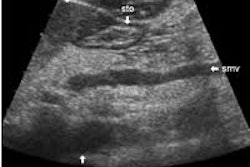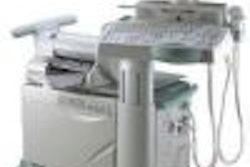First-trimester ultrasound screening for Down syndrome may save money, but it also leads to the loss of more normal fetuses in women younger than 45, according to research presented at the 2002 RSNA meeting in Chicago.
Moreover, "The addition of second-trimester follow-up ultrasound to first-trimester ultrasound does increase detection of additional Down syndrome cases, but does so at significantly increased normal fetal loss rate and increased costs," said Dr. Brian Kott of the University of Washington Medical Center in Seattle.
UW researchers developed three screening algorithms to compare the cost-effectiveness of first-trimester nuchal translucency measurements and second-trimester genetic sonograms:
- Model 1: First-trimester ultrasound.
- Model 2: Second-trimester ultrasound.
- Model 3: First-trimester ultrasound with follow-up second-trimester study.
The study team obtained Medicare CPT codes, relative value units (RVUs), and payments for first- and second-trimester ultrasound from the Medicare Part B Washington 2002 Provider Disclosure Report. Sensitivity, prevalence values, and false-positive rates (5%) for each type of ultrasound examination were obtained from the literature, as were mortality rates for chorionic villus sampling, or CVS (2%), and amniocentesis (.5%).
The researchers also calculated costs for each of the three models, including amniocentesis and CVS (as well as complications), initial serum analytes, and first- or second-trimester abortions. The prevalence of Down syndrome was varied to analyze the changes in societal costs, and sensitivity analyses were performed to determine the effects of normal fetal death as a consequence of the screening models, Kott explained.
"First-trimester screening offers the most cost savings to society for detecting Down syndrome, regardless of sensitivity and prevalence of disease," he said.
The number of normal fetal deaths per diagnosis of Down syndrome at a prevalence below 0.1 were significantly higher for models 1 and 3 compared with model 2, however. This was primarily caused by the higher infant mortality associated with CVS compared with amniocentesis, Kott said.
"At this level of prevalence, we're actually terminating more normal fetuses than we're diagnosing cases of trisomy 21," he said. "The false-positive rate of first-trimester ultrasound would have to be less than 1.25% for model 1, and less than 0.00125% to reduce normal fetal deaths below the standard of model 2," he said.
Normal fetal loss rates become equal for first- and second-trimester ultrasound screening programs at a Down syndrome prevalence of 0.1, which is associated with women 45 and older, the researchers concluded.
The costs and benefits of first-trimester screening were also found in a recent study conducted at the department of obstetrics and gynecology at the University of California, San Francisco. In that study, the study team found that first-trimester screening for Down syndrome with nuchal translucency screening alone or with serum markers was more clinically effective and cost-effective than a second-trimester expanded maternal serum alpha-fetoprotein (AFP) test (American Journal of Obstetrics and Gynecology, November 2002, Vol. 187:5, pp. 1239-1245).
In another recent paper, a multicenter study led by the University of Cincinnati found that genetic sonography performed between a gestational age of 14 and 16 weeks was highly sensitive and statistically superior to genetic sonography performed between 16 and 24 weeks (American Journal of Obstetrics and Gynecology, November 2002, Vol. 187:5, pp. 1235-1238.)
However, other studies have come to a different conclusion. A group from the Perinatology Research Branch of the National Institute of Child Health and Human Development in Bethesda, MD, concluded that offering genetic sonography, followed by amniocentesis, to patients 35 years and older was cost-effective in patients who originally declined invasive testing for the diagnosis of trisomy 21. They also found that this policy resulted in a higher overall detection rate for trisomy 21 without increased risk of pregnancy loss (Journal of Ultrasound in Medicine, January 2002, Vol. 21:1, pp. 5-13).
By Erik L. RidleyAuntMinnie.com staff writer
February 6, 2003
Related Reading
First trimester sonography better than later for detection of Down syndrome, December 20, 2002
Genetic sonogram measures risk of Down syndrome, December 17, 2002
New sonographic marker detects Down syndrome, November 19, 2002
Fetal nasal bone appearance on ultrasound may guide Down syndrome detection, November 8, 2002
Turf Wars in Radiology IV: Radiologists, ob/gyns sound off on fetal imaging, September 26, 2002
Copyright © 2003 AuntMinnie.com



















